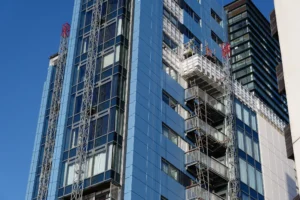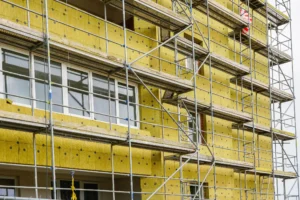The line between construction and sustainability is disappearing — and nowhere is that clearer than in the façade sector. Once treated as a finishing trade, façades are now central to how buildings meet net-zero carbon goals. From energy-generating cladding to circular material systems, this is where engineering, renewables, and environmental design converge. For professionals and employers, the façade has become a new frontier — one where performance, innovation, and sustainability meet.
1) The façade as an energy system
Today’s façades aren’t just barriers against the elements — they’re energy assets in their own right.
With advancements in Building Integrated Photovoltaics (BIPV), dynamic glazing, and smart control systems, façades now actively manage energy, light, and temperature. This evolution means that the building envelope plays a key role in:
-
Reducing operational energy consumption
-
Generating on-site renewable electricity
-
Enhancing occupant wellbeing through natural light and ventilation
-
Lowering lifecycle carbon emissions
In effect, the façade is the building’s first renewable energy interface — harvesting energy, conserving it, and regulating its use.
2) Net-zero targets driving technical innovation
Governments and developers are under increasing pressure to align with net-zero building regulations and ESG commitments.
-
The UK’s Future Homes Standard (2025) and Net Zero Carbon Buildings Standard both emphasise energy efficiency at the envelope level.
-
The EU’s Energy Performance of Buildings Directive (EPBD) sets minimum standards for thermal performance and promotes on-site renewable generation.
-
Investors and occupiers are now prioritising buildings that can prove operational efficiency — creating strong market incentives for innovative façade solutions.
This policy pressure is pushing façade design to become more technologically sophisticated and integrated with renewable systems.
3) Sustainability through materials and circularity
Sustainability in façades goes beyond energy — it’s also about materials, manufacture, and lifecycle impact.
Innovative companies are adopting circular design principles:
-
Using recycled aluminium and glass in curtain walling systems.
-
Designing for disassembly and reuse to minimise waste.
-
Switching to bio-based materials such as timber and natural composites.
-
Implementing digital product passports for full traceability and lifecycle analysis.
This shift is creating demand for sustainability-minded engineers, procurement specialists, and compliance managers who can navigate Environmental Product Declarations (EPDs), embodied carbon calculations, and material transparency frameworks.
4) Collaboration between energy and envelope sectors
The convergence between renewable energy and facade engineering is opening new career pathways and partnerships.
Solar engineers are working alongside façade designers on BIPV façades and sun-shading systems. Energy modelers are collaborating with architects to simulate building performance. Project managers with experience in wind or solar are now leading low-carbon retrofit programmes.
The skills crossover between renewables and façades is accelerating — and professionals who can speak both “languages” are becoming some of the most valuable hires in construction.
5) The new skills shaping façade sustainability
Employers are increasingly looking for candidates who blend technical expertise with sustainability literacy.
High-value skills include:
-
Thermal modelling (using IES, TAS, or similar)
-
Energy and daylight simulation
-
Embodied carbon accounting (One Click LCA, eTool, etc.)
-
Knowledge of BREEAM, LEED, and WELL standards
-
Understanding of ESG reporting requirements
-
Experience with renewable integration (BIPV, smart façades)
As projects become more data-driven, even traditional façade roles now require some degree of digital and environmental competency.
6) Career opportunities: where the growth is
Sustainability-led façade projects are multiplying across commercial, residential, and public infrastructure. Key hiring areas include:
-
Sustainable design engineers for early-stage performance modelling.
-
Façade sustainability consultants advising on materials and lifecycle carbon.
-
Retrofit programme managers leading envelope upgrades for energy efficiency.
-
ESG coordinators ensuring project alignment with investor sustainability frameworks.
-
Manufacturing and R&D specialists developing recyclable or energy-generating products.
For ambitious professionals, this is a sector where technical skill meets purpose — and where innovation directly contributes to climate targets.
7) Employer implications: building sustainable capability
Developers, contractors, and façade specialists are now investing in sustainability skills as a core business competency.
Leading employers are:
-
Embedding carbon literacy into project management and engineering training.
-
Hiring cross-disciplinary teams that combine architecture, energy, and data science.
-
Partnering with specialist recruiters who understand how to identify and attract green-skilled professionals.
-
Redefining job descriptions to include environmental accountability alongside traditional deliverables.
The message is clear: sustainability is not a department — it’s a discipline that now runs through every façade project.
8) Outlook: façades as the face of the green transition
Over the next decade, façades will increasingly embody the principles of the energy transition — efficiency, renewability, and circularity.
As buildings evolve from passive consumers to active participants in energy systems, the façade becomes a critical interface: the bridge between construction and sustainability, form and function, engineering and environment.
That’s why, for talent and technology alike, façades are not just following the green transition — they’re leading it.
🌱 Green Carbon Talent: Where Sustainability Meets Structure
At Green Carbon Talent, we connect professionals who are shaping the future of sustainable construction — from renewable engineers to façade specialists redefining building performance. As we expand into the building envelope sector, we’re proud to support the people and businesses turning sustainability ambition into practical delivery.


